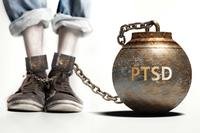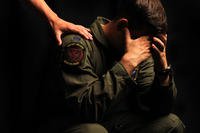As a new generation of service members returns from deployment, the Department of Defense (DoD) is faced with the challenge of identifying the most effective methods of treatment to address posttraumatic stress disorder (PTSD). Prevalence estimates of PTSD symptoms based on self-report surveys among warriors in the conflicts in Iraq and Afghanistan vary, but it has clearly been shown to be a significant problem, especially for those exposed to sustained ground combat.
There are several treatment options that health professionals and clinicians can use to effectively treat service members with PTSD. Since there are a number of factors to consider in treating PTSD (e.g., access to services, availability, safety, patient preferences, etc.), it is important to understand the different types of treatments available to service members.
Prevention
As with all disorders successful prevention of PTSD may be more desirable than even the most effective treatment. To the extent that traumatic experiences themselves may be avoided, PTSD may also be prevented. In the immediate aftermath of traumatic exposures preventive interventions are available, including psychoeducation, brief counseling and prophylactic medication. Although some of these are promising, none have yet been proven to prevent PTSD. A number of early interventions have been utilized for the prevention of PTSD. The most promising of these are public health or population-based interventions informed by the evidence supporting cognitive behavioral therapy for PTSD. Psychological First Aid (ncptsd.org) is one example of a promising early intervention. Similarly, a growing number of well controlled studies have demonstrated the efficacy of early CBT and Exposure-based treatments as an early intervention. Interventions such as these may decrease the likelihood of persons developing PTSD after traumatic exposures; however, additional research is needed to demonstrate this. Conversely, Critical Incident Stress Debriefing (CISD) administered in compulsory groups has been shown to be ineffective for the prevention of PTSD following trauma exposure and is not recommended in the current VA/DoD CPG.
Treatment Options for PTSD
The main treatments for people with PTSD are counseling (known as "talk" therapy or psychotherapy), medications, or both. Although there are a number of treatment options for PTSD, and patient response to treatment varies, some treatments have been shown to have more benefit in general.
Cognitive-behavioral therapy (CBT) is one type of counseling. With CBT, a therapist helps the service member dealing with PTSD understand and change how thoughts and beliefs about the trauma, and about the world, cause stress and maintain current symptoms. The table below describes several types of CBT:
| Type of CBT | Overview / Components | Goal |
|---|---|---|
| Prolonged Exposure Therapy |
| Increase emotional processing of the traumatic event, so that memories or situations no longer result in:
|
| Cognitive Therapy |
|
|
| Cognitive Processing Therapy | Includes elements of Cognitive Therapy and Prolonged Exposure Therapy, including:
|
|
| Stress Inoculation Training |
|
|
| Cognitive Behavioral Therapy for Insomnia (CBT-I) |
|
|
CBT has been shown to be successful in treating PTSD in a number of well controlled studies.5 However, there are a handful of service members for whom certain interventions may be inappropriate or for whom other treatment problems (e.g., co-occurring conditions) may also need to be addressed. Visit this fact sheet from the VA National Center for PTSD for more information on cautions regarding cognitive behavioral interventions within the first month of trauma.
In addition to cognitive behavioral therapy, eye movement desensitization and reprocessing (EMDR) is another type of therapy for PTSD. EMDR uses a combination of talk therapy with specific eye movements. Like the CBTs listed above, EMDR has also been shown to be effective in treating PTSD. In general, it appears that the talk therapy component is helpful, but most evidence suggests that the eye movement component does not add much, if any, benefit. Like other kinds of psychotherapy, the talk therapy component of EMDR can help change the reactions to memories service members experience as a result of their trauma(s).
Additional Types of Counseling
In addition to the treatments described above, other types of counseling may be helpful in treating PTSD.
Through group therapy, service members can talk about their trauma or learn skills to manage symptoms of PTSD (depending on the focus of the group). Many groups are effective and popular among those who have had similar traumatic experiences. Group therapy can help those with PTSD by giving them a chance to share their stories with others, feel more comfortable talking about their own trauma, and by connecting with others who have experienced similar problems or feelings. Some types of cognitive behavioral therapy can also be provided in a group setting.
Family and couples therapy are methods of counseling that include the service member's family members. A therapist helps all of those involved communicate, maintain good relationships, and cope with tough emotions. PTSD can sometimes have a significant negative impact on relationships, making this mode of therapy particularly helpful in some cases.
Pharmacological Approaches
Selective serotonin reuptake inhibitors (SSRIs) are a type of antidepressant medication. SSRIs include citalopram (Celexa), fluoxetine (Prozac), paroxetine (Paxil), fluvoxamine (Luvox), and sertraline (Zoloft). Many, if not most, patients with PTSD will achieve some symptom relief with an SSRI, although the evidence of effectiveness is less convincing in combat PTSD compared to PTSD due to other traumas. Additional medications have been used for specific symptoms with some success (see VA/DoD PTSD Clinical Practice Guideline (CPG) link below for additional information). Prazosin may be promising for trauma-related nightmares. In addition, short-term use of a medication for sleep can be helpful for those who have significant difficulty sleeping immediately after a traumatic event. Longer-term use of sedative/hypnotic medications, such as benzodiazepines, however, has not been shown to be of benefit, and there is some evidence that long-term use of benzodiazepines in PTSD may interfere with psychotherapy.
Complementary and Alternative Medicine
Complementary and Alternative Medicine (CAM) approaches to the treatment of many medical and mental health diagnoses, including PTSD, are in use; the research base to support their effectiveness is improving, but not complete. Acupuncture, a component of traditional Chinese medicine, has been examined for PTSD in a limited number of small Randomized Controlled Trials (RCTs). Although early results are promising, replication of these results in larger studies is needed. Yoga Nidra, a relaxation and meditative form of yoga, has also been used as an adjunctive treatment for PTSD. Formal studies demonstrating its effectiveness for PTSD are currently being conducted, and further research is needed on Yoga Nidra for PTSD before its effectiveness can be commented on. Herbal or dietary supplements have also been used for the treatment of PTSD. Although there have been some studies of their effectiveness, the results of these small RCTs provide insufficient evidence to draw firm conclusions about their effectiveness for PTSD. In addition, the quality and purity of herbals and dietary supplements available in the United States varies widely, further complicating their use. Revisions of the VA/DoD CPGs are currently underway to include a comprehensive review of the evidence for all treatments, including CAM.
Guidelines and Resources
The DoD collaborated with the VA to develop an evidence-based guideline to assist health professionals with the Management of Post-Traumatic Stress. The guideline is available here.
PTSD 101, made available by the VA's National Center for PTSD, is a Web-based educational resource that is designed for practitioners who provide services to military men and women and their families as they recover from combat stress or other traumatic events.
Sources
1. Tyler C. Smith: New onset and persistent symptoms of post-traumatic stress disorder self reported after deployment and combat exposures: prospective population based US military cohort study. British Medical Journal 2007.
2. Hoge CW, Castro CA, Messer SC, McGurk D, Cotting DI, Koffman RL: Combat Duty in Iraq and Afghanistan, Mental Health Problems, and Barriers to Care. New England Journal of Medicine 2004.
3. Hoge CW, Terhakopian A, Castro CA, Messer SC, Engel CC: Association of Posttraumatic Stress Disorder With Somatic Symptoms, Health Care Visits, and Absenteeism Among Iraq War Veterans. American Journal of Psychiatry 2007.
4. Sundin J, Fear NT, Iversen A, Rona RJ, Wessly S: PTSD after deployment to Iraq: conflicting rates, conflicting claims. Psychological Medicine 2010, 40, 367–382.


















